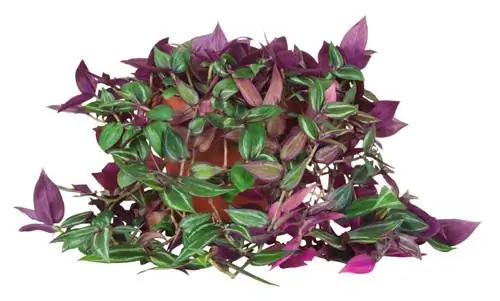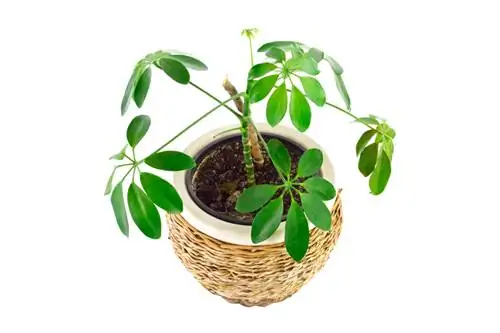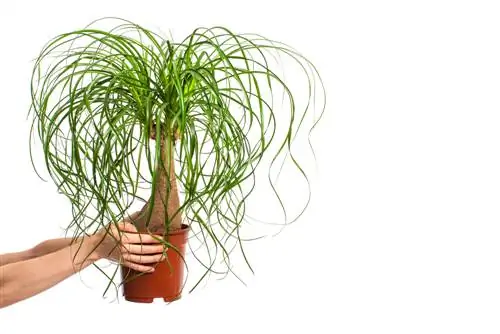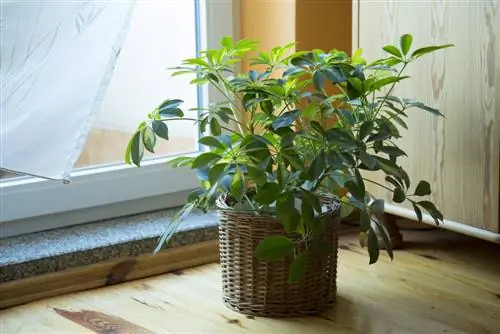- Author admin [email protected].
- Public 2024-01-05 20:48.
- Last modified 2025-01-23 11:21.
The Schefflera, or radiant aralia, is one of the most popular foliage houseplants with its attractively fingered leaves and is also very easy to care for. The varieties of the small Schefflera are available in almost every plant center.
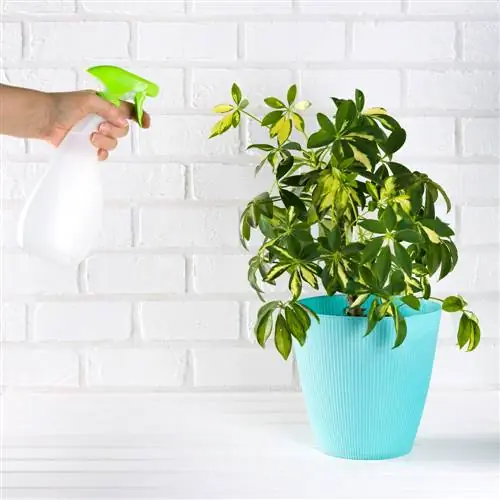
What are the care requirements and possible problems with the Schefflera?
The Schefflera, also known as the Radiant Aralia, is a tropical houseplant with attractive, fingered leaves. It requires a bright but not full sun location, moderate watering and occasional repotting. Yellow or brown leaves can indicate care errors, while pest infestation is possible. Cuttings or seeds are suitable for propagation.
Origin
The plant genus Schefflera comes from tropical and subtropical Asia and Australia. Depending on the species, the areas of origin are somewhat limited - the species most important for local indoor culture, the Schefflera arboricola, is particularly widespread in Taiwan. From there it requires very little care - it is therefore ideal as a houseplant for beginners.
Houseplant
The Schefflera is ideal as a beginner's houseplant because, as a tropical plant, it needs consistently warm temperatures - and you can automatically offer that to it in a heated room. Thanks to its tall, slender growth with less branching, it doesn't take up a lot of space and yet offers an attractive look with beautiful volume thanks to its broadly fingered, beautifully variegated leaves.read more
leaves
The leaves of the radiant aralia are the most important thing from an ornamental gardening perspective. With their broadly fingered arrangement and the light green to cream-colored variegation on a dark green background, they can create a great structural accent in houseplant groups on the windowsill. The individual leaves of the alternate finger arrangements are oval to obovate, evergreen and usually have entire edges, in some species also serrate.
Bloom
The flower plays a rather subordinate role in the indoor culture of radiant aralia - on the one hand because it is not necessarily particularly spectacular. But above all because a specimen kept indoors rarely produces them. So you can consider yourself lucky if your Schefflera gives you one - this is especially possible with an older plant.
The flowers of a Schefflera are racemose umbels in a greenish to yellowish tone with small, hairy bracts. Their finely fluffy appearance creates a nice contrast to the smooth, dark foliage. In the wild the flowering period lasts from July to October, in indoor cultivation it only lasts until August.
The flower characteristics at a glance:
- Schefflera in indoor culture rarely produces them
- grape-like umbels in an inconspicuous color with fine, downy bract hairs
- Flowering time around July to August
read more
Fruit
The fruits that form after flowering are also quite attractive: the mustard-yellow to orange-red, small berries on the dark flower stalks provide a nice splash of color in the foliage.
Which location is suitable?
Like so many tropical plants, the Schefflera requires a relatively bright, but not full sun location. But it can also thrive quite well in a darker corner. In summer you can also put it outside for a while - but it should not be exposed to temperatures below 10°C. In general, it can be kept in a heated room all year round because it also copes well with dry air. What she likes less, however, is drafts.
Watering Schefflera
The water requirement of the radiant aralia is moderate. Only water when the substrate has become completely dry again after the last watering. If the bale is permanently wet, there is a risk of root rot. The Schefflera is also ideal for convenient hydroculture with a soilless substrate made of expanded clay, which is placed in a water nutrient solution in the planter. Then you don't need to water at all.read more
Cut Schefflera correctly
The Schefflera arboricola grows into a stately tree in the wild. Of course that doesn't work in the room. A regular topiary is therefore essential, especially since the radiant aralia is very fast-growing. In principle, it can be cut in the same way as other woody plants. Shoots that are too long are best removed directly above a branch fork. A cut has a rejuvenating effect with vital new growth, especially after a lot of leaf loss after overwintering.read more
Shorten
In order to keep them in check in terms of height and at the same time promote compact, shrubby growth, the side and main shoots should be trimmed regularly. It's best to shorten it in early spring.read more
Bonsai
Due to its rapid growth, the Schefflera is also well suited for bonsai cultivation. However, the freedom of design is limited - because the branches of the ray aralia break relatively easily, so wiring can only be done with great caution. What you can experiment with a lot, however, is shaping the shape by pruning. If you decapitate a young specimen when you purchase it and regularly cut back above the newly sprouting buds, an umbrella-like crown will result.
It is even possible to modify and artistically design the leaves through regular topiary.
To remember:
- Schefflera is well suited for bonsai culture thanks to its fast growth
- Deformation but if possible only by cutting and not by wiring
- Leaves can also be shaped individually by cutting
read more
Repotting
You should repot a young Schefflera relatively often, about once a year. It has a rejuvenating and revitalizing effect on the plant if you shorten its roots slightly. If you discover rotten areas, you can remove them immediately before putting the Schefflera in a new, slightly larger pot.read more
Yellow leaves
If your Schefflera's leaves are turning yellow, it could be a variety of greens. The most likely ones are:
- too wet substrate/root rot
- location too sunny/too dark
Root rot?If you have watered the Schefflera too much and left it too wet, the roots may have become rotten. Remove the plant from the pot and check the root ball for rotten spots. If they are still isolated, you can remove them and place the ball in fresh soil - in the worst case scenario
Wrong location?
If there is too much direct sunlight or in a corner of the room that is too dark, the Schefflera can also react with yellow leaves. Try a different location with moderate lighting conditions.read more
Brown leaves
Brown leaves usually indicate dryness. Possible causes for this are:
- too little water
- too much direct sunlight and heat
- sudden temperature change from warm to cold
Lack of water?Although the Schefflera doesn't need a lot of water compared to some other tropical plants, too little is of course not good either. Check the root ball for dryness and water regularly from now on.
Sunlight and heat?Brown leaves can also simply be sunburn. Keep your Schefflera out of direct sunlight and strong heat.
Temperature changes?
If you want to put the Schefflera outside in the summer, you can do so as long as it is not significantly cooler outside than in the heated room. The Schefflera can also respond to a sudden change in temperature from warm to cold with brown leaves.read more
Loses leaves
When the leaves of the Schefflera change color, it usually drops them after a while. If it loses a lot of leaves without color indication, it may indicate the following:
- location too dark and too cold
- abrupt change in light due to change of location
- too wet substrate
Too dark and too cold?If the Schefflera is too dark, it can drop its leaves. It shouldn't be too cold either - in summer your ambient temperature should not fall below 18°C and in winter 10°C.
Abrupt change in light?If you move your Schefflera to a different location, for example in winter, this can also affect it. Don't subject it to too much change in light - it's best to just leave it in a window seat all year round.
Too wet?
Too wet substrate and root rot can also be the trigger for leaf shedding. Replacing the top layer of soil and removing any rotten root parts can be helpful here.read more
Diseases
Fortunately, the Schefflera is quite robust against diseases. Actually, it only shows unhe althy reactions when certain care errors are made - such as yellow and falling leaves when there is too much water and root rot or a lack of light, brown and burnt leaves when it is dry and hot. However, these care errors can usually be easily corrected.read more
Pests
Pests, however, are occasionally an issue. Sometimes the Schefflera can be attacked by the following pests:
- Mealybugs
- Spider mites
- Scale insects
- Thrisps
MealybugsYou can easily recognize the mealybugs by the typical woolly webs on the leaves. The best way to spray mealybugs is with a mixture of water, a little spirit and a little soap (€117.00 on Amazon).
Spider mitesSpider mites also reveal themselves clearly through thread-like webs. The best thing to do is to first rinse it with water and then wrap the plant under foil. The mites cannot tolerate moist air and suffocate under the foil cover.
Scale insectsScale insects can attack almost every houseplant. They prefer to attach themselves to the branches and shoots, the stems and the undersides of the leaves. If the infestation is still weak (check regularly!), the parasites can simply be wiped off with a damp cloth. For more severe infestations, spraying with a water-nettle broth or an oily preparation is suitable.
Thrisps
These partly winged insects feel particularly comfortable in dry, warm conditions. There is therefore an increased risk of them infecting your radiant aralia, especially in summer. The best way to combat them is in the same way as scale insects: First, rinse with water and, if the infestation is more stubborn, attack them with a water-nettle broth or water-tansy broth. Preparations based on neem tree oil have also proven successful.read more
Propagate Schefflera
Radiated aralia can be propagated relatively easily using cuttings. To do this, you cut a shoot that is not yet woody and simply let it root in a glass of water. You can also sow a Schefflera. At a warm soil temperature of 18-20°C, a seed germinates after about 2 to 3 weeks. A warm, moist, uniform growing climate under foil is also recommended.read more
Cuttings
In addition to the water glass, you can also root the cutting in potting soil. However, a soil temperature of around 18°C should be ensured. Of course, you also have to keep the substrate evenly moist.read more
Poisonous to cats
Radiation anals are slightly toxic - they contain oxalate crystals in all parts of the plant, which, however, are only harmful when consumed in large quantities. Skin contact with the leaves is usually not critical, but can also lead to slight irritation. Oral intake, on the other hand, is not to be taken lightly, especially with cats, who are known to enjoy a close relationship with houseplants.
The problem is that cats cannot break down the oxalic crystals in their intestines and only partially excrete them. However, this can lead to kidney stone formation, damage the bladder and trigger arthritis. If you keep a cat in the house, you should avoid having a radiant aralia as a new roommate.read more
Food
It is of course anything but advisable for humans to snack on the pretty leaves of the ray aralia. Of course, this particularly applies to small children, for whom even small amounts of oxalate ingestion can become noticeable - through mucous membrane irritation, vomiting and diarrhea. If there are small children in the household, keep a ray aralia only at a height that is out of reach of the younger ones.
Varieties
When it comes to Schefflera arboricola varieties, a distinction can first be made between the green ones and the variegated ones. Which of these two groups you lean towards is, on the one hand, a matter of taste. On the other hand, the associated varieties each have slightly different location requirements.
Green varietiesThe purely green varieties generally require less light than the light variegated ones. They are also suitable for a corner of a room that is less flooded with light and needs to be filled with attractively structured foliage.
Schefflera Compacta
This variety has dark, lush green finger leaves and, as its name suggests, a compact growth habit. This makes it particularly suitable for bonsai culture. Indoors it grows to a height of around 1.30 to 1.50 m. Like all green ray aralia, it gets by with relatively little light.
Schefflera Amate
The Schefflera Amate stands out with its large, dark green and very shiny leaves. It tolerates a partially shaded location well and is generally easy to care for - making it an ideal office plant. Overall, it grows almost as tall as the Schefflera Compacta.
Varimented varietiesWith variegation, the finger leaves of the Schefflera naturally radiate a special color and structural aesthetic and can be a real eye-catcher in the room. The variegated varieties have to be a little lighter, but otherwise they are not very maintenance-intensive.
Schefflera Gold Capella
As its name suggests, the variegation of this variety is yellowish-golden, which gives it a special appeal. It is also one of the classic indoor aralias and can often be found in offices. The variegation can vary quite significantly within the foliage, as it only spreads more widely with larger leaves. The young shoots provide a fine, dark green contrast. The Schefflera Gold Capella requires a relatively bright location, but like all radiation aralia, it must be protected from direct sunlight.
Schefflera Renate
This variety, like the Schefflera Diane, is characterized by leaves that are slit at the tips. This gives the foliage another structural accent in addition to the light variegation. The Schefflera Renate should also be kept relatively bright, otherwise it is easy to care for and only needs moderate watering.



